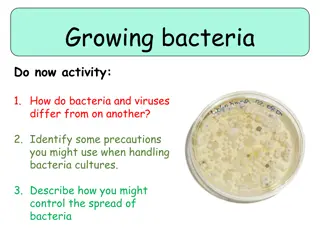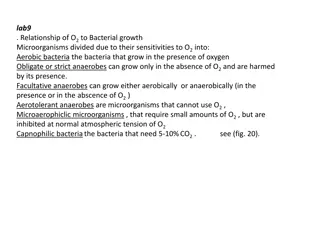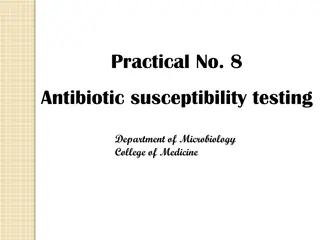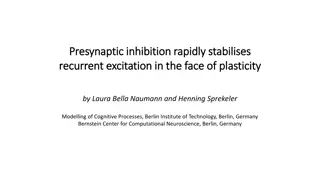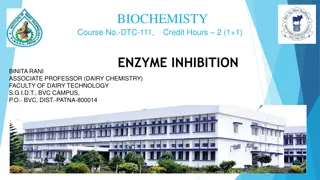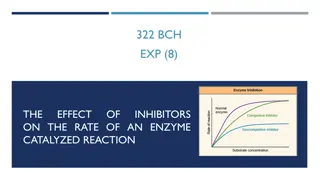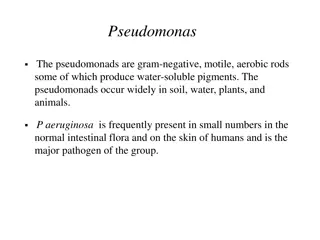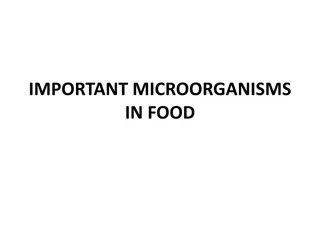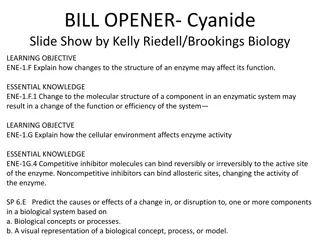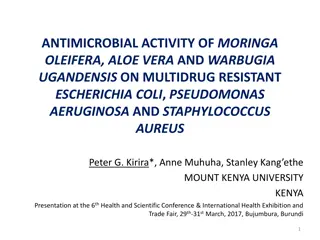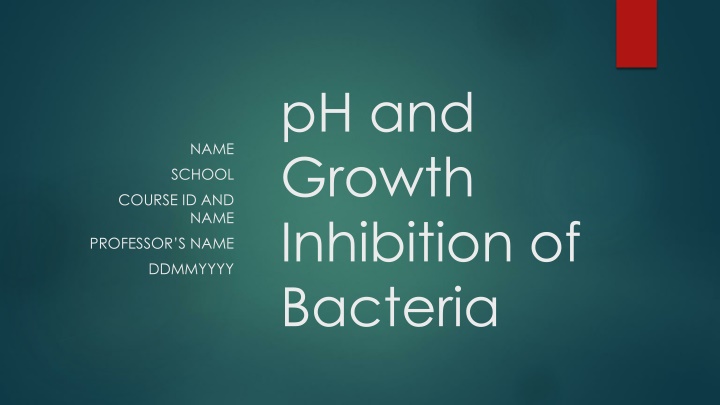
pH and Growth Inhibition of Bacteria in Biological Processes
Explore the impact of pH on bacteria growth inhibition in biological processes, focusing on how altering pH affects structure, function, and complexity. Understand the significance of pH in chemical reactions, thermodynamics, and genetic expression, as well as its role in bacterial dispersion and physiochemical properties. Dive into research on pH sensitivity, growth conditions, and environmental interactions with bacteria populations.
Download Presentation

Please find below an Image/Link to download the presentation.
The content on the website is provided AS IS for your information and personal use only. It may not be sold, licensed, or shared on other websites without obtaining consent from the author. If you encounter any issues during the download, it is possible that the publisher has removed the file from their server.
You are allowed to download the files provided on this website for personal or commercial use, subject to the condition that they are used lawfully. All files are the property of their respective owners.
The content on the website is provided AS IS for your information and personal use only. It may not be sold, licensed, or shared on other websites without obtaining consent from the author.
E N D
Presentation Transcript
pH and Growth Inhibition of Bacteria NAME SCHOOL COURSE ID AND NAME PROFESSOR S NAME DDMMYYYY
Introduction pH affects the structure and function of physiochemical properties Study hypothesis that altering pH affects the structure, function, and process in biological processes Biological processes depend on the environment pH affects the speed and complexity of biological processes Fermentation processes increase with increase in acidity
Rationale pH determines the function and structure of biological molecules (Sanchez-Clemente et al., 2018) Ph affects chemical reactions thermodynamic forces, especially those involving metabolic protons (Sanchez-Clemente et al., 2018) Bacteria growth conditions primarily influence biological processes (Kurniawan et al., 2018) pH changes in solutions result in alterations in bacterial dispersion and consequent physiochemical properties (Alpaslan, et al., 2017)
Background Research identifies pH as a significant factor affecting the acidity of products in biological processes (Yang et al., 2018) Different physiochemical properties affect Ph-sensitivity (Yang et al., 2018) Extreme pH changes are associated with extinction of bacterial population in an environment of chemical process (Ratzke and Gore, 2018) pH has significant influence in the growth of organisms It also influences genetic expression, with low pH being ideal for optimal expression (Huang et al., 2017)
Alpaslan, E., Geilich, B. M., Yazici, H., & Webster, T. J. (2017). pH-controlled Cerium Oxide nanoparticle inhibition of both gram-positive and gram-negative bacteria growth. Scientific Reports, 7(1), 1-12. Retrieved from https://www.nature.com/articles/srep45859.pdf References Huang, X., Zhang, K., Deng, M., Exterkate, R. A., Liu, C., Zhou, X., . . . Cate, J. (2017). Effect of arginine on the growth and biofilm formation of oral bacteria. Archives of Oral Biology, 82, 256-372. doi:10.1016/j.archoralbio.2017.06.026 Kurniawan, S., Purwanti, I., & Titah, H. (2018). The effect of pH and aluminium to bacteria isolated from aluminium recycling industry. Journal of Ecological Engineering, 19(3), 154-161. Retrieved from http://yadda.icm.edu.pl/yadda/element/bwmeta1.element.baztech-70cf0bb0- de1e-4642-9c72-33d4f65fadc5/c/kurniawan_the_effect_3_2018.pdf Ratzke, C., & Gore, J. (2018). Modifying and reacting to the environmental pH can drive bacterial interactions. PLOS Biology, 16(3). doi:10.1371/journal.pbio.2004248 Sanchez-Clemente, R., Igeno, M. I., Poblacion, A. G., Guijo, M. I., Merchan, F., & Blasco, R. (2018). Study of pH changes in media during bacterial growth of several environmental strains. Proceedings of Environment, Green Technology, and Engineering International Conference, 2(20), 1-52. doi:10.3390/proceedings2201297 Yang, Y., Reipa, V., Liu, G., Meng, Y., Wang, X., Mineart, K. P., . . . Sun, J. (2018). pH-sensitive compounds for selective inhibition of acid-producing bacteria. ACS Applied Materials and Interfaces, 10(10), 8566-8573. doi:10.1021/acsami.8b01089


